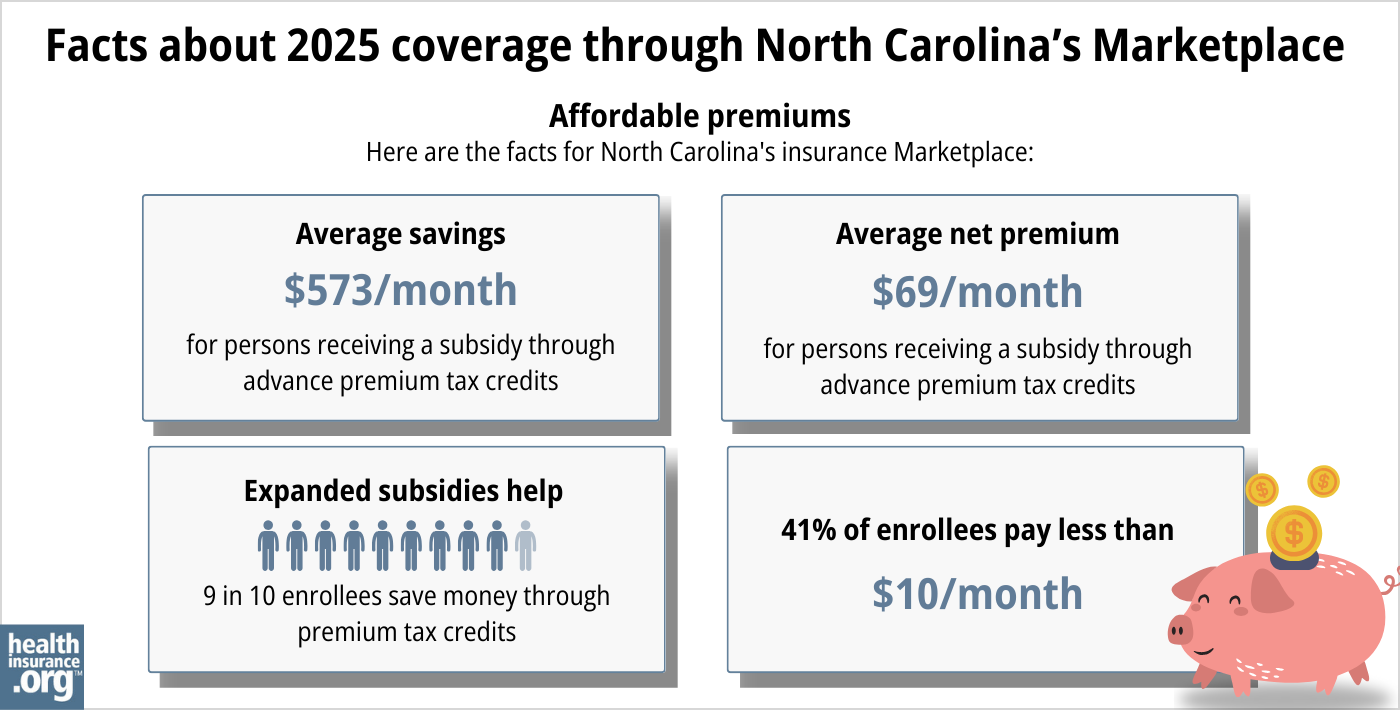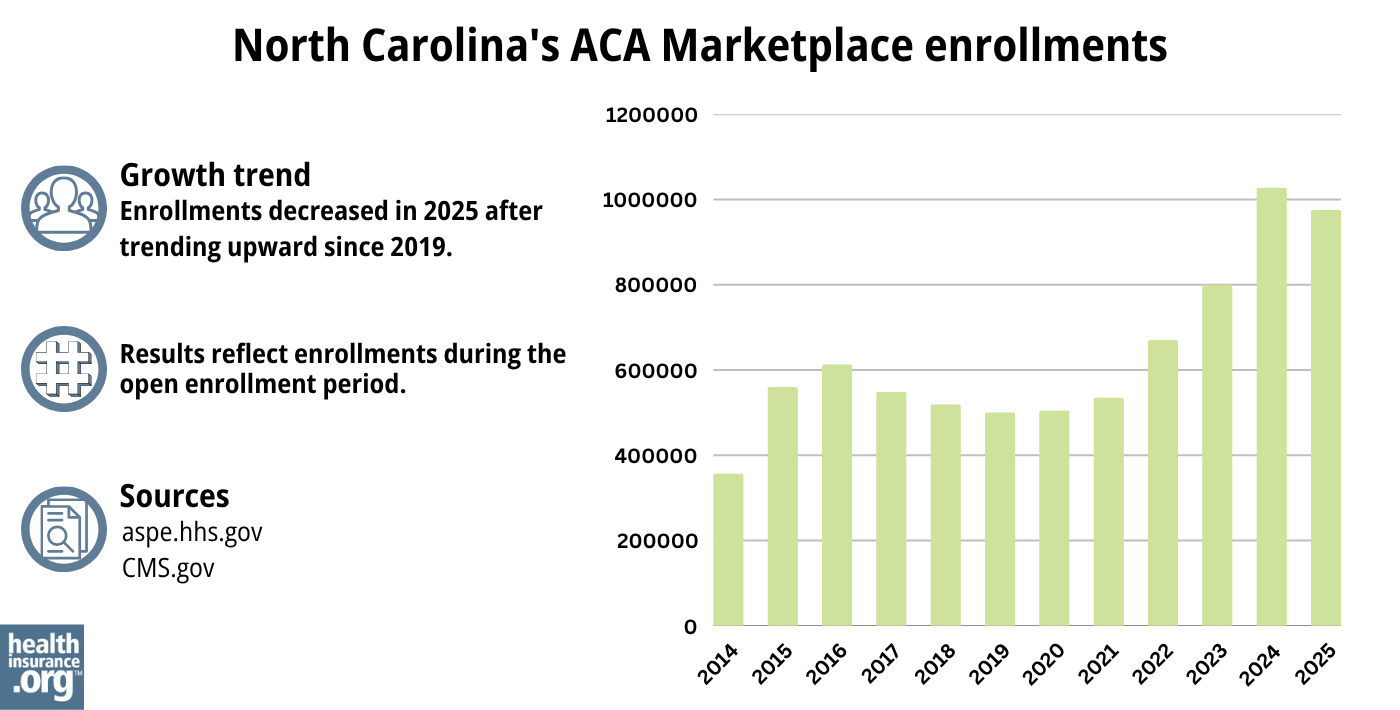Home > Health insurance Marketplace > North Carolina
North Carolina Marketplace health insurance in 2026

Compare ACA plans and check subsidy savings from a third-party insurance agency.

North Carolina ACA Marketplace quick facts
North Carolina health insurance Marketplace guide
This guide, including the FAQs below, was developed to help you understand the health insurance options and possible financial assistance available to you and your family in North Carolina.
The health plan options found in North Carolina’s ACA Marketplace/exchange are designed to cover people who don’t have access to Medicare, Medicaid, or an employer’s health plan. North Carolina uses the federally facilitated health insurance exchange platform — Healthcare.gov — for residents to purchase its ACA Marketplace plans.
North Carolina’s Marketplace provides access to health insurance products from six private insurers for 2026,3 down from nine in 2025 (see below for details about carrier exits and premium changes for the remaining carriers).
The federal government helps pay for insurance through an advance premium tax credit (APTC) if you buy coverage from the exchange and are eligible for the tax credit based on your income. Some enrollees are also eligible for cost-sharing reductions, which reduce out-of-pocket costs on Silver-level plans for eligible enrollees.
North Carolina Medicaid expansion took effect on December 1, 2023, making hundreds of thousands of North Carolina residents newly eligible for Medicaid. Some were previously in the coverage gap, while others were previously eligible for subsidies to offset the cost of Marketplace coverage.4
Frequently asked questions about health insurance in North Carolina
Who can buy Marketplace health insurance in North Carolina?
To qualify for health coverage through the North Carolina Marketplace, you must:5
- Live in North Carolina
- Be lawfully present in the United States
- Not be incarcerated
- Not be enrolled in Medicare
Eligibility for financial assistance (premium subsidies and cost-sharing reductions) depends on your income and how it compares with the cost of the second-lowest-cost Silver plan in your area – which depends on your age and location. In addition, to qualify for financial assistance with your Marketplace plan you must:
- Not have access to affordable health coverage through your employer. If your employer offers coverage but you feel it’s too expensive, you can use our Employer Health Plan Affordability Calculator to see if you might qualify for premium subsidies in the Marketplace.
- Not be eligible for Medicaid or CHIP.
- Not be eligible for premium-free Medicare Part A.6
- If married, file a joint tax return.7
- Not be able to be claimed by someone else as a tax dependent.7
When can I enroll in an ACA-compliant plan in North Carolina?
In North Carolina, the open enrollment period for individual/family health coverage runs from November 1 to January 15.8
Your coverage will start on January 1 if you enroll before December 15. But if you apply between December 16 and January 16, your coverage will begin on February 1.9
Starting in the fall of 2026, the open enrollment period will be shorter. In states like North Carolina that use HealthCare.gov as their Marketplace, the enrollment window will run from November 1 through December 15, and all policies selected during open enrollment will take effect January 1. This is due to a federal rule change that was finalized in 2025.
Outside of open enrollment, a qualifying event is generally necessary to enroll or make changes to your coverage, although some people can qualify for a special enrollment period without a specific qualifying life event.
If you have questions about open enrollment, you can learn more in our comprehensive guide to open enrollment. We also have a comprehensive guide to special enrollment periods.
How do I enroll in a North Carolina Marketplace plan?
If you’re eligible for an ACA Marketplace plan, there are several ways you can enroll:
- Online through HealthCare.gov
- By phone at (800) 318-2596
- With local help in your community from an agent/broker, Navigator, or certified application counselors (these individuals are available to help you over the phone, online, and sometimes in-person, depending on your preference)
- Through an approved enhanced direct enrollment entity.10
How can I find affordable health insurance in North Carolina?
North Carolina uses the federally facilitated exchange for individual market plans, so residents who buy their own health insurance enroll through HealthCare.gov.
During the open enrollment period for 2025 coverage, 94% of the people who enrolled in Marketplace coverage in North Carolina were eligible for premium tax credits (subsidies) that averaged $573/month. After subsidies were applied, the average enrollee’s monthly cost was about $97/month, including those who paid full price (if we only consider the 94% of enrollees who qualified for subsidies, their average net premium was just $69/month).11
In addition to premium tax credits, the ACA also provides cost-sharing reductions (CSR) to enrollees with household income up to 250% of the federal poverty level, as long as they purchase a Silver-level plan.12 Forty-five percent of North Carolina Marketplace enrollees were receiving CSR benefits as of early 2025.13
Between the premium subsidies and cost-sharing reductions, you may find that an ACA plan is the most affordable and robust health insurance option for you.

Source: CMS.gov 14
How many insurers offer Marketplace coverage in North Carolina?
Six insurers offer Marketplace plans in North Carolina for 2026, with coverage areas that vary from one insurer to another:3
- Ambetter/Centene
- AmeriHealth Caritas
- Blue Cross and Blue Shield of NC
- Cigna
- Oscar
- UnitedHealthcare
Nine insurance companies offered individual/family health plans through North Carolina’s Marketplace for 2025,[efm_note]”North Carolina: *Final* avg. unsubsidized 2025 #ACA rate changes: +7.0% (updated)” ACA Signups. Oct. 29, 2024[/efn_note] but three of them are leaving North Carolina’s individual market at the end of 2025.
Aetna, Celtic/WellCare, and CareSource are exiting the state’s market. According to their market withdrawal filings in SERFF, Aetna has about 130,000 enrollees in North Carolina who will need to select new coverage for 2026. Celtic/WellCare has only 25 individual market enrollees in North Carolina, but they too will need to select new plans during open enrollment.15 HAP CareSource has about 3,000 enrollees,16 all of whom need to pick new plans for 2026.17
Are Marketplace health insurance premiums increasing in North Carolina?
The following average rate changes have been approved for 2026 for the insurers that offer individual/family plans in North Carolina’s health insurance Marketplace (calculated before subsidies are applied; after-subsidy increases are much more significant, as described below, because Congress hasn’t extended the federal subsidy enhancements that are scheduled to expire at the end of 2025).
North Carolina’s ACA Marketplace Plan 2026 APPROVED Rate Increases by Insurance Company |
|
|---|---|
| Issuer | Percent Increase |
| Aetna Health Inc. | Exiting market |
| Ambetter/Centene | 23.4% |
| AmeriHealth Caritas | 36.4% |
| Blue Cross and Blue Shield of NC | 29.4% |
| CareSource | Exiting market |
| Celtic/WellCare | Exiting market |
| Cigna | 27.5% |
| Oscar | 16.9% |
| UnitedHealthcare | 32.3% |
Source: North Carolina Department of Insurance3 Market exits based on SERFF Filings15 and carrier statements17
The weighted average rate increase for 2026 is almost 28% in North Carolina.16 These significant rate increases are driven in part by the impending expiration of the federal subsidy enhancements that have been in place since 2021, and by the Marketplace rules that were finalized by HHS in 2025. Both will have the effect of reducing enrollment, which tends to drive premiums higher (the people who cancel their coverage will tend to be healthy, so the overall risk pool will become less healthy).
But average after-subsidy premium increases will be much larger than 28%, unless Congress extends the subsidy enhancements that are scheduled to expire at the end of 2025. That had not happened as of early November, when open enrollment was already underway. As a result, here are some examples of the sort of after-subsidy premium increases that people are seeing in Charlotte, North Carolina:18
- 40-year-old earning $40,000:
- Lowest-cost plan in 2025 is $31/month
- Lowest-cost plan in 2026 is $151/month
- 60-year-old earning $63,000:
- Lowest-cost plan in 2025 is $187/month
- Lowest-cost plan in 2026 is $949/month (due to the return of the subsidy cliff)
For perspective, here’s a summary of how average unsubsidized premiums have changed each year in North Carolina’s individual/family market:
- 2015: Average increase of 12%19
- 2016: Average increase of 28.1%20
- 2017: Average increase of 24.3%21
- 2018: Average increase of 14.8%22
- 2019: Average decrease of 3.9%23
- 2020: Average decrease of 5.6%24
- 2021: Average preliminary increase of 4%25
- 2022: Average increase of 3.2%26
- 2023: Average increase of 7.93%27
- 2024: Average decrease of 1.3%28
- 2025: Average increase of 7%[efm_note]”North Carolina: *Final* avg. unsubsidized 2025 #ACA rate changes: +7.0% (updated)” ACA Signups. Oct. 29, 2024[/efn_note]
How many people are insured through North Carolina’s Marketplace?
975,110 people enrolled in private plans through the North Carolina Marketplace during the open enrollment period for 2025 coverage.29 Although most areas of the country reached record-high enrollment in 2025, that was not the case in North Carolina (see chart below).
The record enrollment level in North Carolina came the year before, when 1,027,930 people enrolled during the open enrollment period for 2024 coverage.30
The record high enrollment for 2024 happened even though Medicaid expansion took effect in North Carolina in December 2023.
Before Medicaid expansion, people with income between 100% and 138% of the poverty level were eligible for Marketplace subsidies, whereas they’re now eligible for Medicaid instead. So states tend to see a dip in their Marketplace enrollment after expanding Medicaid. But North Carolina’s enrollment reached a significant new record high for 2024.
The increase in enrollment (which had been ongoing in North Carolina since 2021) is driven in part by the American Rescue Plan (ARP). Under the ARP, ACA’s premium subsidies are larger and more widely available. The ARP’s subsidy enhancements have been extended through 2025 by the Inflation Reduction Act.31 But as noted above, these subsidy enhancements will expire at the end of 2025, unless Congress acts to extend them again. If they expire, enrollment is expected to drop sharply in 2026, as coverage will be less affordable.
The enrollment increase in 2024 was also due to the “unwinding” of the pandemic-era Medicaid continuous coverage rule. Between June 2023 and April 2024, more than 272,000 people in North Carolina were disenrolled from Medicaid and transitioned to a Marketplace plan.32

Source: 2014,33 2015,34 2016,35 2017,36 2018,37 2019,38 2020,39 2021,40 2022,41 202342 2023,43 2024,44 202529
What health insurance resources are available to North Carolina residents?
HealthCare.gov
800-318-2596
State Exchange Profile: North Carolina
The Henry J. Kaiser Family Foundation overview of North Carolina’s progress toward creating a state health insurance exchange.
North Carolina Institute of Medicine (NCIOM)
Health Insurance Smart NC
Assists people insured by private health plans, Medicaid, or other plans in resolving problems pertaining to their health coverage; assists uninsured residents with access to care.
Toll free: 1-877-885-0231
Managed Care Patient Assistance Program
Serves consumers who are members of managed health benefit plans.
(919) 733-6272 / Toll-Free: 1-866-867-6272 (in North Carolina only)
[email protected]
Community Care of North Carolina
Legal Aid of North Carolina (855-733-3711)
Louise Norris is an individual health insurance broker who has been writing about health insurance and health reform since 2006. She has written hundreds of opinions and educational pieces about the Affordable Care Act for healthinsurance.org.

Looking for more information about other options in your state?
Need help navigating health insurance options in North carolina?
Explore more resources for options in NC including short-term health insurance, dental, Medicaid and Medicare.
Speak to a sales agent at a licensed insurance agency.
Footnotes
- ”2025 OEP State-Level Public Use File (ZIP)” Centers for Medicare & Medicaid Services, Accessed May 13, 2025 ⤶ ⤶
- ”2026 Plan Year ACA Rate Filings” North Carolina Department of Insurance – Life & Health Division. July 31, 2025 *The above is based on the most current data available. ⤶
- ”2026 Plan Year ACA Rate Filings” North Carolina Department of Insurance – Life & Health Division. Accessed Nov. 2, 2025 ⤶ ⤶ ⤶
- Questions and Answers about Medicaid Expansion. North Carolina Medicaid Division of Health Benefits. Accessed November 2023. ⤶
- ”A quick guide to the Health Insurance Marketplace” HealthCare.gov ⤶
- Medicare and the Marketplace, Master FAQ. Centers for Medicare and Medicaid Services. Accessed November 2023. ⤶
- Premium Tax Credit — The Basics. Internal Revenue Service. Accessed May 10, 2024 ⤶ ⤶
- “When can you get health insurance?” HealthCare.gov, 2023 ⤶
- “When can you get health insurance?” HealthCare.gov, 2023 ⤶
- “Entities Approved to Use Enhanced Direct Enrollment” CMS.gov, Aug. 9, 2024 ⤶
- ”2025 Marketplace Open Enrollment Period Public Use Files” CMS.gov, Accessed Aug. 12, 2025 ⤶
- ”APTC and CSR Basics” Centers for Medicare & Medicaid Services. June 2024. ⤶
- ”Effectuated Enrollment: Early 2025 Snapshot and Full Year 2024 Average” CMS.gov, July 24, 2025 ⤶
- “2025 Marketplace Open Enrollment Period Public Use Files” CMS.gov, May 2025 ⤶
- ”SERFF tracking number CELT-134533905 and AETN-134525406″ North Carolina SERFF Filings. Accessed Aug. 12, 2025 ⤶ ⤶
- ”2026 FINAL Gross Rate Changes – North Carolina: +27.7%; what happened to ~263,000 “missing” enrollees?? (updated)” ACA Signups. Nov. 1, 2025 ⤶ ⤶
- ”General Plan Information” CareSource. Accessed Nov. 2, 2025 ⤶ ⤶
- ”See Plans & Prices” (zip 28105) HealthCare.gov Accessed Nov. 2, 2025 ⤶
- Analysis Finds No Nationwide Increase in Health Insurance Marketplace Premiums. The Commonwealth Fund. December 2014. ⤶
- FINAL PROJECTION: 2016 Weighted Avg. Rate Increases: 12-13% Nationally* ACA Signups. October 2015. ⤶
- Avg. UNSUBSIDIZED Indy Mkt Rate Hikes: 25% (49 States + DC). ACA Signups. August 2016. ⤶
- 2018 Rate Hikes. ACA Signups. October 2017 ⤶
- 2019 Rate Hikes. ACA Signups. October 2018. ⤶
- 2020 Rate Changes. ACA Signups. October 2019. ⤶
- 2021 Rate Changes. ACA Signups. October 2020. ⤶
- 2022 Rate Changes. ACA Signups. October 2021. ⤶
- UPDATED: FINAL Unsubsidized 2023 Premiums: +6.2% Across All 50 States +DC. ACA Signups. Accessed November 2023. ⤶
- North Carolina: *Final* Avg. Unsubsidized 2024 #ACA Rate Changes: -1.3% (Updated). ACASignups.net, October 2023 ⤶
- “2025 Marketplace Open Enrollment Period Public Use Files” CMS.gov, May 2025 ⤶ ⤶
- ”Health Insurance Marketplaces 2024 Open Enrollment Period Report” CMS.gov. March 22, 2024 ⤶
- “Health Insurance Marketplaces 2023 Open Enrollment Report” CMS.gov, Accessed August 2023 ⤶
- HealthCare.gov Marketplace Medicaid Unwinding Report. Medicaid.gov. Data through April 2024; Accessed Aug. 15, 2024 ⤶
- “ASPE Issue Brief (2014)” ASPE, 2015 ⤶
- “Health Insurance Marketplaces 2015 Open Enrollment Period: March Enrollment Report”, HHS.gov, 2015 ⤶
- “HEALTH INSURANCE MARKETPLACES 2016 OPEN ENROLLMENT PERIOD: FINAL ENROLLMENT REPORT” HHS.gov, 2016 ⤶
- “2017 Marketplace Open Enrollment Period Public Use Files” CMS.gov, 2017 ⤶
- “2018 Marketplace Open Enrollment Period Public Use Files” CMS.gov, 2018 ⤶
- “2019 Marketplace Open Enrollment Period Public Use Files” CMS.gov, 2019 ⤶
- “2020 Marketplace Open Enrollment Period Public Use Files” CMS.gov, 2020 ⤶
- “2021 Marketplace Open Enrollment Period Public Use Files” CMS.gov, 2021 ⤶
- “2022 Marketplace Open Enrollment Period Public Use Files” CMS.gov, 2022 ⤶
- “Health Insurance Marketplaces 2023 Open Enrollment Report” CMS.gov, 2023 ⤶
- “Health Insurance Marketplaces 2023 Open Enrollment Report” CMS.gov, 2023 ⤶
- ”HEALTH INSURANCE MARKETPLACES 2024 OPEN ENROLLMENT REPORT” CMS.gov, 2024 ⤶

